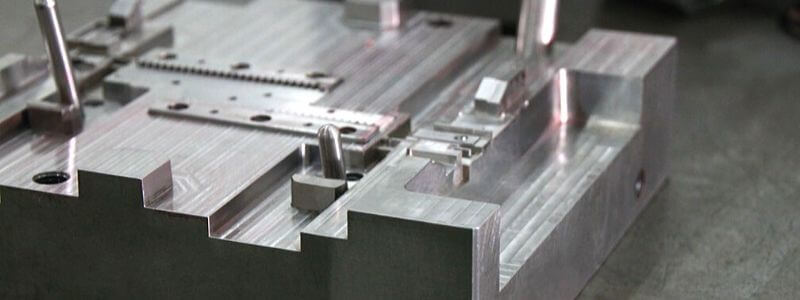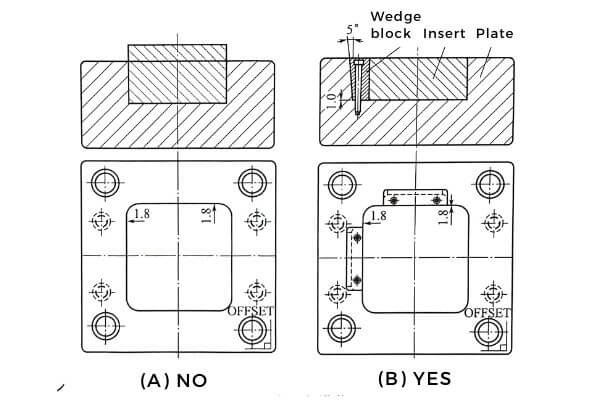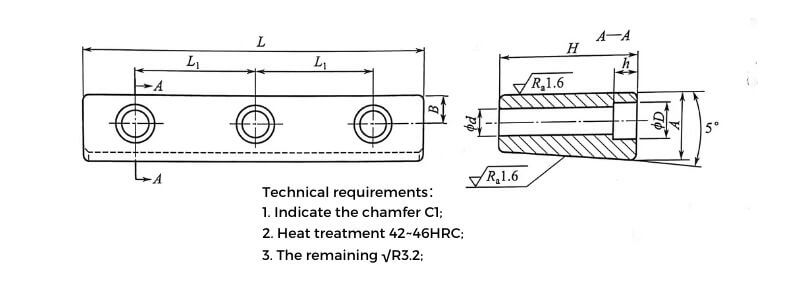
Generally, the cavity and core of the mold are of a unitary structure. However, the processing of complex shaped cavities and cores is very difficult. Processing accuracy is also limited. The use of insert structure can improve the precision and processing.
How to design the insert reasonably? There are 9 small details here. These can help you design mold inserts better.
1.The mold inserts avoid sharp corners.
Properly and rationally design the mold inserts. Avoid sharp corners on the insert parts. Otherwise the mold will fail prematurely.
2.Consider the rationality of the part processing technology.
Properly and rationally design the mold inserts. Avoid sharp corners on the insert parts. Otherwise the mold will fail prematurely.
3.The core insert is too long.
Properly and rationally design the mold inserts. Avoid sharp corners on the insert parts. Otherwise the mold will fail prematurely.
4.Consider the comprehensive factors.
1)Generally, the mold of a single cavity should adopt a monolithic structure. In terms of cost, it is not advisable to use an insert structure.
2)The multi-cavity mold of the small product should adopt an insert structure.
3)It is not possible to consider only the material difference between the template and the inlay material. In principle, should ensure that mold life.
5.Large parts with complex shapes.
For large parts with complex shapes. The overall structure is prone to internal stress or deformation. Therefore, the design should be used for the insert structure to prevent premature failure of the die.
6.Use mold inserts to avoid exhaust problems.
For small cores and deeper ribs. Difficulties in exhausting will make the ribs insufficiently formed. The use of the insert structure will not be air entrapment, and the molding is convenient.
7.Oversized movable mold and fixed-die inserts.
The core of the mold exceeding 200mmX200mm. Directly placed in the mold, it is not easy to disassemble and assemble. It should be fixed by means of a wedge block. As shown in Figure (b). This ensures the accuracy of positioning and is easy to assemble and disassemble.

8.Clearance is provided between the wedge block and the mold base.
The bottom of the wedge block should have a gap of 0.5-1 mm from the bottom of the mold base. For example, the coaxial key and the keyway of the sleeve are matched up and down. Otherwise, there may be a gap between the moving core and the side of the template. As the picture shows. The specific dimensions are shown in the table.

| L | H | A | B | L1 | D | d | h |
|---|---|---|---|---|---|---|---|
| 100 | 29.5 | 17 | 8 | 35 | 11 | 7 | 6.5 |
| 120 | 19 | 14 | 7 | 40 | 11 | 7 | 6.5 |
| 140 | 24 | 17 | 8 | 55 | 11 | 7 | 6.5 |
| 140 | 39.5 | 20 | 8 | 55 | 11 | 7 | 6.5 |
9.The polish process should be considered when designing.
For arc face plastic parts. And the parting line of the product is the joint surface of the mold. If the conventional mold is designed as a whole. Articles tend to have misalignment or stepping in the shape. In order to avoid such a situation. The mold should be insert structure. This will ensure the quality of the shape.
If you have any other questions, please feel free to contact us.
